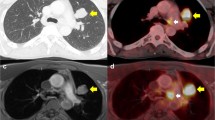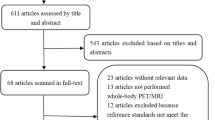Abstract
Purpose
To evaluate the clinical benefit of positron emission tomography (PET)/computed tomography (CT) in patients with advanced melanoma, primarily not selected for surgery based on management changes and survival data using the linked evidence approach (LEA).
Methods
A total of 201 18F-FDG PET/CT examinations (n = 33, stage III and n = 168, stage IV) in 119 melanoma patients, primarily not scheduled for surgery, were analysed regarding their impact on clinical management. Patients were selected from a prospective oncological PET/CT registry. The three PET/CT indication groups included unclear lesions in conventional imaging (n = 8), routine follow-up after multiple surgeries (n = 115) and therapy response evaluation of systemic therapy (n = 78). PET/CT-induced management changes were categorized either as major (change from follow-up to surgical or systemic treatment or vice versa, change from surgery to systemic therapy or vice versa) or minor (modifications in systemic therapy). The expected benefit of changes was determined via the linked evidence approach (LEA) connecting registry data, outcome data including overall survival and evidence of diagnostic accuracy of PET/CT based on existing literature.
Results
Related to the total study cohort, a change of management after PET/CT was observed in 48% of scans, including 10% minor and 38% major changes. Major changes involved a shift either from follow-up (33/201) or therapy pause (7/201) to systemic therapy, to surgical or other local therapy (26/201) and BSC (2/201). Nine out of 201 cases resulted in treatment pause of systemic therapy. We could confirm the prognostic value of PET/CT-based management by observing a 5-year survival rate more than roughly doubled in patients followed up after tumour exclusion or under local therapy compared with patients under systemic therapy. We could argue for a patient benefit from PET/CT-based management changes using results on accuracy and therapeutic effects from the literature.
Conclusion
The use of PET/CT in advanced melanoma patients, primarily not considered for surgery, resulted in frequent changes of management associated with a relevant expected clinical benefit especially in patients classified by PET/CT as tumour-free or eligible for radical surgery.




Similar content being viewed by others
Abbreviations
- CI:
-
Confidence interval
- CM:
-
Contrast media
- 18F-FDG PET/CT:
-
18-Fluorine fluorodeoxyglucose positron emission tomography/computed tomography
- fig:
-
Figure
- i.v.:
-
Intravenous
- GCP:
-
Good clinical practice
- HR:
-
Hazard ratio
- LDH:
-
Lactate dehydrogenase
- LEA:
-
Linked evidence approach
- MBq:
-
Megabecquerel
- mg/dl:
-
Milligramme/decilitre
- OP:
-
Operation
- OS:
-
Overall survival
- PFS:
-
Progression-free survival
- RCT:
-
Randomized clinical trial
- RFA:
-
Radiofrequency ablation
- S-100:
-
S-100 protein
- sn:
-
Sensitivity
- SUVavg:
-
Average standard-uptake value average
- sp.:
-
Specificity
- tab:
-
Table
References
Svedman FC, et al. Stage-specific survival and recurrence in patients with cutaneous malignant melanoma in Europe - a systematic review of the literature. Clin Epidemiol. 2016;8:109–22.
Gwadry-Sridhar F, et al. Resource utilization and costs of managing patients with advanced melanoma: a Canadian population-based study. Curr Oncol. 2017;24(3):168–75.
Serra-Arbeloa P, et al. Cost of cutaneous melanoma by tumor stage: a descriptive analysis. Actas Dermosifiliogr. 2017;108(3):229–36.
Pfannenberg C, et al. Prospective comparison of 18F-fluorodeoxyglucose positron emission tomography/computed tomography and whole-body magnetic resonance imaging in staging of advanced malignant melanoma. Eur J Cancer. 2007;43(3):557–64.
Pfannenberg C, Schwenzer N. Whole-body staging of malignant melanoma: advantages, limitations and current importance of PET-CT, whole-body MRI and PET-MRI. Radiologe. 2015;55(2):120–6.
Petersen H, et al. FDG PET/CT in cancer: comparison of actual use with literature-based recommendations. Eur J Nucl Med Mol Imaging. 2016;43(4):695–706.
van Tinteren H, et al. Effectiveness of positron emission tomography in the preoperative assessment of patients with suspected non-small-cell lung cancer: the PLUS multicentre randomised trial. Lancet. 2002;359(9315):1388–93.
Merlin T. The use of the ‘linked evidence approach’ to guide policy on the reimbursement of personalized medicines. Perinat Med. 2014;11(4):435–48.
Forschner A, et al. Impact of 18F-FDG-PET/CT on surgical management in patients with advanced melanoma: an outcome based analysis. Eur J Nucl Med Mol Imaging. 2017;44(8):1312–1318.
Pfannenberg C, et al. Practice-based evidence for the clinical benefit of PET/CT-results of the first oncologic PET/CT registry in Germany. Eur J Nucl Med Mol Imaging. 2019;46(1):54–64.
Danielsen M, et al. Positron emission tomography in the follow-up of cutaneous malignant melanoma patients: a systematic review. Am J Nucl Med Mol Imaging. 2013;4(1):17–28.
Wieder HA, et al. 18FDG-PET to assess recurrence and long term survival in patients with malignant melanoma. Nuklearmedizin. 2013;52(5):198–203.
Vensby PH, et al. The value of FDG PET/CT for follow-up of patients with melanoma: a retrospective analysis. Am J Nucl Med Mol Imaging. 2017;7(6):255–62.
Lutgendorf SK, Sood AK, Antoni MH. Host factors and cancer progression: biobehavioral signaling pathways and interventions. J Clin Oncol. 2010;28(26):4094–9.
Rueth NM, et al. Is surveillance imaging effective for detecting surgically treatable recurrences in patients with melanoma? A comparative analysis of stage-specific surveillance strategies. Ann Surg. 2014;259(6):1215–22.
Yushak M, et al. Systemic therapy options for patients with unresectable melanoma. Am Soc Clin Oncol Educ Book. 2017;37:661–72.
Forschner A, et al. Improvement of overall survival in stage IV melanoma patients during 2011-2014: analysis of real-world data in 441 patients of the German Central Malignant Melanoma Registry (CMMR). J Cancer Res Clin Oncol. 2017;143(3):533–40.
Long GV, et al. Overall survival and durable responses in patients with BRAF V600-mutant metastatic melanoma receiving dabrafenib combined with trametinib. J Clin Oncol. 2016;34(8):871–8.
Rodger M, Ramsay T, Fergusson D. Diagnostic randomized controlled trials: the final frontier. Trials. 2012;13:137.
Fryback DG, Thornbury JR. The efficacy of diagnostic imaging. Med Decis Mak. 1991;11(2):88–94.
Merlin T, et al. The “linked evidence approach” to assess medical tests: a critical analysis. Int J Technol Assess Health Care. 2013;29(3):343–50.
Albano D, et al. Clinical and prognostic value of 18F-FDG-PET/CT in the restaging process of recurrent cutaneous melanoma. Curr Radiopharm. 2019;26(13):4610–4618.
Leiter U, et al. The natural course of cutaneous melanoma. J Surg Oncol. 2004;86(4):172–8.
Nelson DW, et al. Impact of effective systemic therapy on metastasectomy in stage IV melanoma: a matched-pair analysis. Ann Surg Oncol. 2019;26(13):4610–8.
Levine MN, Julian JA. Registries that show efficacy: good, but not good enough. J Clin Oncol. 2008;26(33):5316–9.
Hillner BE, et al. The National Oncologic PET Registry (NOPR): design and analysis plan. J Nucl Med. 2007;48(11):1901–8.
Acknowledgements
First, we thank all the patients who agreed to participate in the registry. Furthermore, we want to thank the staff of the PET/CT centre and Radiopharmacy of the Tuebingen University for their continuous support in patient care. Special thanks to our referring dermatologists who provided us with excellent clinical data for our study group.
Funding
This study was funded by the young scientists’ programme of the German Network “Health Services Research Baden-Wuerttemberg” of the Ministry of Science, Research and Arts in collaboration with the Ministry of Employment and Social Order, Family, Women and Senior Citizens, Baden-Wuerttemberg. Additional financial support was provided through the Wilhelm Sander Foundation (Wilhelm Sander-Stiftung, Goethestraße 74, 80336 Munich, Germany, project-number 2015.176.1).
Author information
Authors and Affiliations
Corresponding author
Ethics declarations
Conflict of interest
The authors declare that they have no conflict of interest.
Ethical approval
All procedures performed in this study were in accordance with the ethical standards of the institutional research committee and with the 1964 Helsinki declaration and its later amendments or comparable ethical standards. The study was reviewed and approved by the institutional review board and the local ethics committee (reference number 064/2013BO1).
Informed consent
Informed consent was obtained from all individual participants included in the study.
Additional information
Publisher’s note
Springer Nature remains neutral with regard to jurisdictional claims in published maps and institutional affiliations.
This article is part of the Topical Collection on Miscellanea
Rights and permissions
About this article
Cite this article
Olthof, SC., Forschner, A., Martus, P. et al. Influence of 18F-FDG PET/CT on clinical management and outcome in patients with advanced melanoma not primarily selected for surgery based on a linked evidence approach. Eur J Nucl Med Mol Imaging 47, 2313–2321 (2020). https://doi.org/10.1007/s00259-020-04733-x
Received:
Accepted:
Published:
Issue Date:
DOI: https://doi.org/10.1007/s00259-020-04733-x




